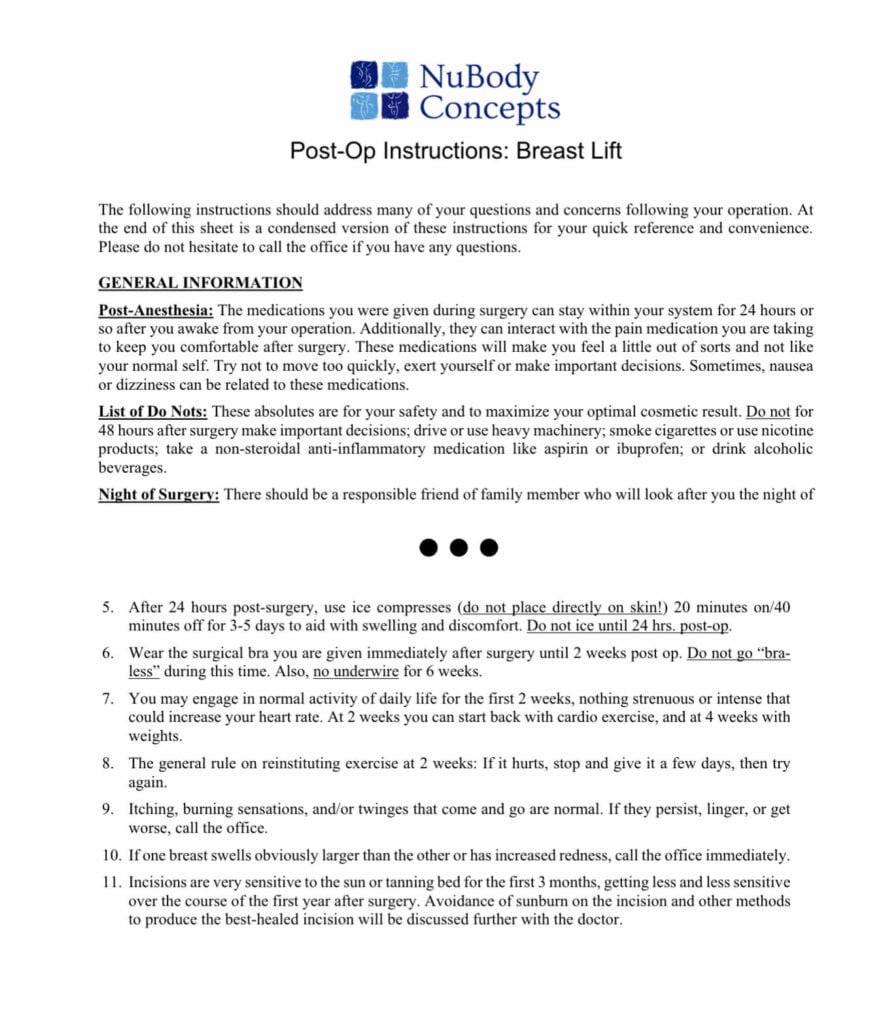
Medically reviewed by Dr. John Rosdeutscher – Written by Sine Thieme
If you are experiencing breast asymmetry, sagging, or if you have noticed that your nipples point downward, a breast lift can be an excellent option for you to enhance your appearance and confidence.
However, as with any surgical procedure, you may have questions concerning the potential risks of a breast lift procedure or any complications that could arise.
The good news is that according to the American Society of Plastic Surgeons, breast lift surgery is a very safe cosmetic procedure with minimal risks. Below we address the potential risks, side effects, and rare complications that may accompany a breast lift.
What is a Breast Lift?
Breast lift surgery is a cosmetic procedure designed to enhance the shape, firmness, and youthful appearance of the breast as well as elevate them to a more suitable position.
You may also hear a breast lift be referred to as a mastopexy – a treatment that can reposition and resize the nipple-areolar complex to be in better proportion with the breasts.
Who a Breast Lift is for
A mastopexy is often considered if:
- Your breasts sag due to excess breast tissue, skin, or have lost volume and form with age.
- Your breasts are no longer supported, leading to your nipples falling below the crease of your breasts.
- Your areola has stretched out of proportion to your breast.
- Your breasts are asymmetrical – one falling lower than the other.
Considerations Before Undergoing a Breast Lift
Are You Considering Pregnancy?
If you are considering pregnancy in the near future you may want to delay cosmetic surgery until after your pregnancy. This is especially true for surgery affecting the breasts. Pregnancy often stretches the breast tissue and can offset any work that was done.
Are You Planning on Breastfeeding?
How a mastopexy affects breastfeeding is a much-discussed topic and is an understandable concern for many women. Even though breastfeeding is often possible after a breast surgery – the nipples aren’t separated from the subdermal breast tissue – some women may experience difficulty producing enough milk post-op. While future breastfeeding doesn’t preclude a breast lift in any way, it is a topic you should research and discuss with your plastic surgeon.
Is Breast Lift Surgery Safe?
Because a mastopexy is a surgical procedure that requires anesthesia, some women may be concerned about the dangers and risks of breast lifts. While any and all surgical procedures carry a degree of risk for potential complications, a breast lift has an excellent safety profile. This is especially true when performed by a highly trained, board-certified member of the American Society of Plastic Surgeons. Especially one with extensive experience doing breast augmentations (i.e. breast lift, breast implants, breast reduction).
Before your surgery, you should confirm that you’re being treated in a well-staffed and equipped surgical facility, that an experienced anesthesiologist or Certified Registered Nurse Anesthesist (CRNA) will be administering anesthesia and monitoring vitals, and that a board-certified plastic surgeon is performing the actual surgery.
In addition to a smooth, safe procedure and the best patient care, it is paramount to comply with the surgeon’s pre-surgery and post-op instructions so that your outcome isn’t negatively affected (more on that below).
Risks of Breast Lift Surgery
Now that we have determined that a breast lift is a safe breast enhancement procedure, we’d like to address any potential side-effects and risks of the procedure. Below are side-effects and complications of breast lifts that your surgeon will discuss with you in your pre-op consultation.
Infection
Although it is uncommon to have an infection from a breast lift, during the post-op recovery you may expose your wounds to various contaminants – which increases the risk of infection. Signs of an infection can include: persistent pain, abnormal swelling or redness, pus or skin that feels warm to the touch, and fever. If one or more of these symptoms are present, contact your surgeon for advice.
One of the primary ways you can mitigate the risk of infection is to have your surgery performed at an accredited surgery center that ensures a sterile surgical environment.
Hematoma
Excessive, uncontrolled bleeding may occur in very rare occasions following a breast lift surgery. This risk can be greatly reduced if your surgeon has reviewed the patient’s medical history and if the patient has carefully followed the pre-op advice given by the surgeon to avoid certain medications and supplements.
Adverse Reaction to Anesthesia
Some of the most common symptoms following the administration of anesthesia include mild nausea and dizziness. These symptoms often go away on their own after a few hours. However, some patients may have a poor response to the anesthetic. Some underlying health conditions may increase the risk of an adverse reaction. A qualified anesthesiologist should be able to anticipate a patient’s response early and minimize any life-threatening risks.
Delayed Healing
Improper closure of the wound, tissue necrosis, or poor wound after care can drastically affect the time it takes to heal post-op. A patient with a history of smoking may be at a higher risk of poor healing. The technique used may also affect the time to heal and fully recover. In the case of a wound reopening due to dead skin, your surgeon will remove any excess skin and re-suture both sides of the incision.
Loss of Sensation
A temporary change of sensation, feeling of numbness, or a loss of feeling may occur in or around the surgical site (especially around the areolas and nipples due to repositioning). In rare cases, the loss of sensation may be permanent. Don’t be alarmed though! A temporary loss or change of sensation is fairly common and will rectify itself over time.
Unsatisfactory Aesthetic Results
Unfortunately, there are times when a patient may be unsatisfied with their procedure. This is very uncommon. The satisfaction rates for breast lifts is generally very high. However, in some cases, a breast lift may accentuate asymmetry, leave a permanent, noticeable scar, or may not have firmed the breasts enough. In other cases, a patient may be unsatisfied with the position of the nipples/areolas. Revision surgery may be necessary to fix these issues.
Side Effects of Breast Lift Surgery
While mastopexy is a relatively low-risk procedure, patients may experience bleeding, infection, seroma or hematoma, scarring, poor healing of incisions, loss of breast or nipple sensitivity, uneven size or shape of breasts, blood clots, or need for a revision surgery.
As we have stated before, a breast lift is a fairly low-risk procedure. However, the most common side-effects of a breast lift include:
- Post-op bleeding.
- Swelling and bruising.
- Changes in nipple or breast sensation.
- Dull aches and pains.
These symptoms are fairly common and can be reduced during your recovery with prescription medication, a compress, and rest. It may be helpful to maintain close contact with your surgeon during your recovery period and notify him or her immediately if you notice any signs or symptoms of infection, or have difficulty breathing.
Will My Scarring be Permanent?
Just like with most surgeries, the incision lines from a breast lift are permanent. However, they will fade and become near invisible over time. Also, a skilled plastic surgeon can “disguise” the incisions by working along the natural folds of the breast as well as the natural edge where the areola meets the lighter skin of the breast. Breast lifts typically have a very high satisfaction rate among patients, and permanent scarring does not seem to be a significant problem.
Minimizing Breast Lift Risks and Side Effects
Prior to Your Surgery
Before any patient undergoes any plastic surgery, they should first visit their plastic surgeon for a consultation to discuss the risks and benefits. During your initial visit, your plastic surgeon will likely:
- Review your medical history: It is important to be prepared to answer any questions regarding your current or past medical history. If your family has a history of breast cancer, he or she may ask for mammogram or breast biopsy results. You should also reveal any medications you have taken or are currently taking, as well as any previous surgeries you have had.
- Do a physical exam. Your surgeon may also do a physical exam of your breasts to best determine which treatment option is best for you. Skin tone, elasticity, position of the nipples and areolas, and symmetry will be important. Your doctor may request taking a picture of your breasts, with your consent, for your medical record.
- Discuss your expectations. Why do you want a breast lift? What are you hoping for in terms of appearance? This is a great time for you to discuss risks and benefits of a breast lift.
After Your Surgery
Following your surgery, the most important way you can avoid or mitigate any potential breast lift risks is to carefully follow your surgeon’s post-op instructions. You may be instructed to wear bandages or a support bra to minimize swelling and support your breasts throughout the healing process. Your recovery may take several weeks or months, but with your surgeon’s guidance, you may be able to return to your daily routines sooner than later.

We hope that we’ve given you a better understanding about breast lift safety and risks. Please don’t hesitate to contact us if you have any other questions.
If you are ready to get started, use the pink button to schedule a consultation with our board-certified plastic surgeon in Nashville or Memphis.












